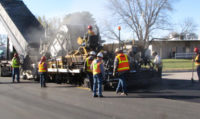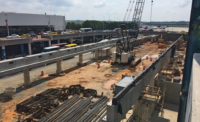...$500-million expansion of Terminal 2 at San Diego International Airport and a new runway at Chicago O’Hare International Airport. “There is some growth, but it’s all tied to built-up capital programs that address long-standing needs,” agrees Fred Werner, CEO of AECOM’s U.S. infrastructure practice in New York City, which was recently awarded a 10-year contract to manage development of a new runway and a terminal expansion as part of a $1.3-billion capital-improvement program at Fort Lauderdale International Airport.

Transit Takes the Fast Track
While the economy and high gas prices may have put the squeeze on highway work, they’ve boosted the fortunes of the transit sector, with increased ridership boosting interest in both new systems and expansion projects. Major initiatives include Hous- ton’s $1.46-billion program to construct four new light-rail lines, the Delaware River Port Authority’s $500-million, 17.5-mile diesel light-rail line between Lyndenwall and Glassboro, N.J., and numerous streetcar projects under consideration from Sacramento to Columbus, Ohio.
Honolulu hopes to break ground later this year for the first segment of what will eventually be a $5.4-billion, 20-mile elevated light-rail line. In November 2008, Los Angeles voters approved a sales tax increase that will provide $40 billion to transit and other projects over the next 30 years.
But the most talked-about element of transit has been high-speed rail, thanks to the Obama administration’s pledge of $8 billion in immediate funding and an additional $5 billion to be spread over five years, beginning in 2010.
Eric Keen, national transportation director for HDR, Omaha, considers investment in high-speed rail long overdue. “But it’s good the federal government is taking the lead in planning and funding a system that will serve us for years to come,” he says.
STV’s Amodei, whose firm is leading the preliminary engineering and EIS for the Orange County to Los Angeles segment of California’s 800-mile High- Speed Train project, agrees the investment is a great start, “but more will be needed to even approach what other countries already have,” he says.
Although the glow of stimulus funding has yet to fade, the transportation industry’s attention already has turned to the impeding congressional debate over the successor to SAFETEALU, the far-reaching transportation-funding legislation that expires at the end of September.
House Transportation and Infrastructure Committee Chairman James L. Oberstar (D-Minn.) vowed in early June there would be no extensions of the existing bill. So far, however, there has been little consensus on the thorny issue of how the multibillion- dollar bill will be funded, either from the existing or modified gas-tax structure, vehicle miles traveled, infrastructure banks or a combination of multiple sources.
“That’s where the battle will be,” Yarossi says. Opinions also are mixed as to whether Congress will produce a new bill on time or repeat the protracted process of its predecessor. What does appear certain is the next iteration of the bill will be unlike its predecessors.
“The next bill will be transformative, with fewer funding categories, broader federal policies and more local latitude on how to meet them,” Lyman predicts, adding the bill also will take incremental steps toward a non-gas tax revenue system similar to the Oregon Dept. of Transportation’s mileage-based fee system.
Keen believes the new bill “will place greater emphasis on creating more livable communities and a more consensus-driven planning and approval process. Transit is likely to receive greater attention, with more funds for Small Starts projects and simplification of the [Federal Transist Administration’s] approval process.”
Amodei thinks another round of stimulus funding is not out of the question, particularly with fears that...






